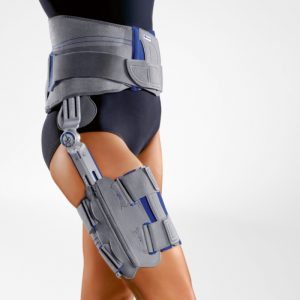If you have had a hip surgery or have dislocated your hip, you will likely be required to use a hip brace for about two to four weeks after your surgery or dislocation.
Will I be required to wear a hip brace?
Ask your doctor if you will need to wear a brace after your hip surgery. The need for a brace depends on the type of surgery you have, the severity of your injury, your unique anatomy, age and lifestyle.
Likely after any hip surgery–especially if you are required to use crutches, you will need to wear a hip abduction brace. Always wear a hip brace while you use crutches unless otherwise directed by your doctor.
Not only after surgery, but often after a hip dislocation, it is necessary to wear a hip abduction brace.
How long will I need to wear a hip brace?
Again, the length of time required to wear a hip abduction brace will depend on the type of surgery you had, the severity of the dislocation (and if there were any fractures), bone and ligament strength, your lifestyle and activity, age and unique anatomy. Most often a brace is worn between two and four weeks for surgery recoveries and a few weeks to a month or two for hip dislocations.
Wear the brace while you are up and about and definitely when using crutches. You will likely need to use a brace for two to four weeks after a surgery.
What kind of brace? What is it called?
When recovering from hip surgeries you may encounter the following two types of braces.
Hip Abduction Brace:
Hip abduction braces may be used for dislocations or after a hip surgery. The brace is meant to hold the thigh bone (femur) into the hip socket and prevent extra movement.
Abduction is the medical term for the movement of a body part away from the body. This brace prevents the leg from excessive movements away from the body. It also prevents hyperflexion, meaning the movement of the knee toward the chest. Wearing the brace prevents dislocation of the hip joint.
If you are using crutches after a hip replacement or microfracture surgery, you should always use a brace while you are using crutches. You do not need to wear the brace while sleeping, using the bathroom, while using a continuous passive motion machine, while showering, while laying on your stomach or while icing your hip. Your physical therapist may have you do some exercises without wearing a hip brace. If you want to do an activity without the brace, always check in with your physician first.
Continuous Passive Motion Machine:
A continuous passive motion machine technically isn’t a brace, but resembles one. You may use one in the hospital or at home. It is a machine that has been known to promote healing of the joint by moving the joint continuously.
Generally it is worn for four to six hours per day and may be used for up to two weeks. You can use it while sleeping or awake, and may need to split up the time you use it so you don’t get too sore.
CPM machines have settings on them to allow you to increase flexibility. You will be taught and encouraged by your physician or physical therapist on how to increase, decrease or otherwise manage the settings on your machine.
You should not wear your hip abduction brace while using the CPM machine.
How will it feel? Should I expect discomfort?
The brace may feel a little limiting. It is meant to stabilize the joint and prevent excessive movement. You will not be able to sit at a normal 90 degree angle, as 90 degrees is too much flexion (knee toward chest) for the hip joint at this stage of recovery. Sitting in a recliner or with pillows under your back may be helpful. (Helpful hint: try not to sit on anything too low to the ground as this is a difficult position to get out of with a hip brace on!)
If the brace is loose or moves, make sure that the straps are snug.
If the brace is digging into your hip, make sure it is positioned correctly and adjust the straps–they may need to be tighter.
What if it is painful?
If you experience pain due to the brace call your doctor, as the brace itself should not be painful.
You may experience pain as a result from the injury, be it a dislocation, microfracture or surgery.
Your doctor will review complications related to pain and inflammation (like infection). They will also likely prescribe you medications like Motrin or Norco for pain management for after surgery.
What does it look like?
A hip abduction brace has two harder pieces, each lined with a cushy pad. The two harder pieces are placed on the outside of your waist and on your thigh. Those two pieces are connected by an ‘arm’ that has a small joint on itself, this too is positioned on the outside. The small joint is what will need to be  adjusted to a certain angle prescribed by your physician. Each of the harder pieces has a strap on it, which is how it stays on your body. One strap will go around your waist, and the other around your thigh. This type of brace is worn on the outside of your clothing.
adjusted to a certain angle prescribed by your physician. Each of the harder pieces has a strap on it, which is how it stays on your body. One strap will go around your waist, and the other around your thigh. This type of brace is worn on the outside of your clothing.
How do I put it on?
The first few days after surgery you will need the assistance of another person to get into your hip brace.
You doctor or physical therapist will fit you for a brace before your surgery. They will also teach you how to properly use it and have it adjusted to an appropriate setting.
- First you want to open all the straps on the brace.
- Make sure you are dressed comfortably before you put your brace on since it goes on over your clothes! A long cotton shirt and sweatpants would be ideal.
- You will wear the brace on the injured leg. Put the thigh part of the brace around your leg and the waist part of the brace around your waist. The straps will open to your front. The brace pieces should be on the outside (lateral) part of of your hip and leg.
- The waist portion of the brace should be positioned in the area above your hips and below your ribs (close to your belly button). Fasten the waist strap so that it is snug.
- Then, fasten the thigh strap. Your leg will be positioned slightly out to the side and the angle of your hip joint in the brace may feel a little straighter than normal, and you may not be able to sit appropriately while using the brace, this is normal and the correct use of the brace.
- Your doctor will have the angles set or instruct you on how to set them. You will likely need to adjust the settings several times throughout the recovery time so that the hip can increase in strength and flexibility.
What if I need to wash the brace?
If you need to wash the brace (and your doctor permits you remove it temporarily), you can remove the pads of the brace and wash them. Don’t forget to look carefully at how they were positioned on the brace before removing them–maybe even snap a photo on your phone so you can remember how to reassemble it later.
The pads can be washed by hand in warm water and a mild detergent; rinse well and lay flat to dry. Plastic and other hard parts of the brace can be wiped with a damp cloth.

How to I get a hip abduction brace?
You should ask your doctor if they have recommendations of where to obtain a hip abduction brace. They may give you a prescription to use in getting the brace.
You will likely be directed to a medical equipment store. You may be able to rent or buy hip braces from these stores. If this is not an option, they can be purchased through online stores like Amazon. (On Amazon, the cost may range from $115-$300.)
Make sure to clarify with your doctor what to look for, best brands, or required features.
